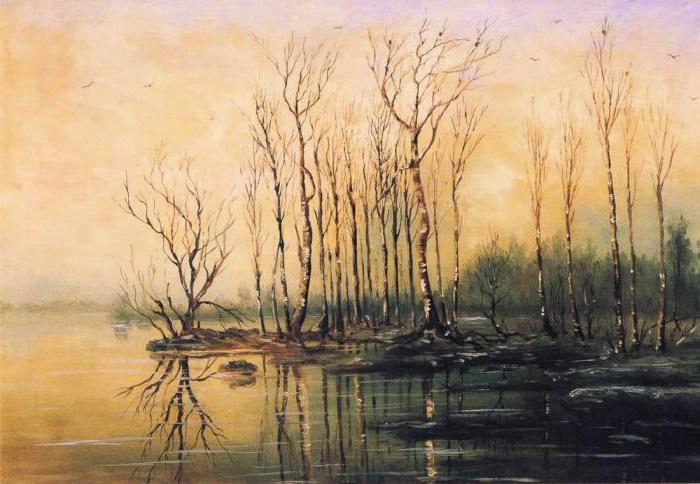It is amazing how this clumsy powerful stern merchant's son - Alexei Savrasov - subtly felt and no less subtly reflected the original Russian landscapes on his canvases. Here is a portrait of Alexei Kondratievich Savrasov by Vasily Perov.
The artist looks at us sternly, gloomily, incredulously. As if asking: “What do you want my work with? After all, it does not portray vivid Italian nature, but only undressed trees in the spring, the wide Volga, views of distant monasteries or the Kremlin. What do you see in them? ”
Rural View, 1867
Already having students, working as the head of the landscape class at the school, Alexei Savrasov wrote the most ordinary village, located on the hilly banks of a narrow stream, the slopes of which are covered with soft grass-murava.
In the foreground, a beekeeper, beehives and cherry blossoms (not only the Japanese see the beauty of cherry blossoms), while the branches of the trees themselves are still bare. They have not yet been leafed. Gracefully and whimsically bent trunks and branches, stretching to the sky. It is ours - ordinary, soft, despite a sunny joyful day. Still draws from the earth cool, and the air that filled the picture, has already warmed up. When a river involuntarily follows its course, it flows into a lake or into a larger river. On the horizon is a narrow light sand spit. A gently green birch grove descends from a small slope to the river. Alexei Savrasov showed the discreet charm of the vast expanses to which every Russian is so accustomed.
"Elk Island in Sokolniki", 1869
From his native Moscow, he did not have to go anywhere in search of a dense forest. In the foreground we see familiar clay puddles through which gati are thrown so that the owner can approach a herd of cows grazing on the edge of a pine forest.
With love, Alexey Savrasov looks at the green edge in the distance and the powerful wedge of a
pine forest that crashes into it. And, as usual, we see the painter’s favorite detail - the bare trunks of the mast forest, which hides near the horizon, merging with dark clouds swirling near the ground. The sky itself changes the tonality from light golden in the center to saturated gray-blue. A native Muscovite, Alexei Savrasov used to see these discreet colors of the Moscow region since childhood. Probably, even when he closed his eyes, they stood before his mental gaze.
Unclaimed Spring
It is she who is depicted on a small canvas by Alexei Savrasov "Rooks Have Arrived" (1871). This image is so reliable that the look, as if you are on the street, runs across, not stopping from the snow with thawed holes and deep muddy puddles, which reflect the sky and willow bushes growing nearby, then up, to where clouds float in the blue expanse the same shade as the snow below.
The earthly and the heavenly are united together. And above all stands the silent rumble of rooks, fighting over their old, blackening with powerful heaps of nest branches on birches, and building new ones. The air smells of
thawed snow and spring. Naked white birches with thin branches are graphically drawn against the sky. A white church with a bell tower in the distance and a field and forest extending to the horizon. What is native this landscape, which we observe everywhere and everywhere in the middle non-chernozem Russia, is his most generalized image. The paintings of Alexei Savrasov will more than once reflect the face of the beginning of spring, but he will not create the second such masterpiece. And who else would write this?
Pictures of Alexei Kondratievich Savrasov
The predecessor of Savrasov in the image of the Russian landscape can be considered A.G. Venetsianova. But the theme of this singer of nature was more inclined to reflect the peasant life that he saw in his estate. Savrasov is gradually moving away from the original romantic traditions, where trees are painted with lush crowns, where there are huge boulders covered with low grass, and the whole tone of the picture is dark, and the tender blue of the sky covered with clouds only gleams slightly - “View in the vicinity of Oranienbaum” (1854 ) He begins to carefully peer at every time of the year, finding for himself a special charm in them. But most of all his trunks, branches, branches of trees attract his attention. Their whimsical bends, when they reach for the sun, their weave. The artist is attracted by early spring. "High Water" (1868) is a magnificent picture of an awakening nature, which "meets the morning of the year through sleep."

The birches almost flooded the flood. And now they are standing, reflected in the mirror of calm water so that, it seems, we see not just their repetition, but their roots, like a crown, which cannot be seen otherwise. Later, Maurits Escher, who investigated symmetry and infinity, will come to this reception. But the innovator in this field, who did not pose such cunning tasks, was undoubtedly A.K. Savrasov. The artist raised many students who scattered from under his wing. Their names and works became significant milestones in Russian painting
(K. Korovin, I. Levitan,
M. Nesterov).